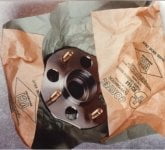Protecting Metal: Rust Most Likely Before and After Transport
 If you’re shipping any kind of metal, corrosion is a concern. Understanding the environmental moisture of your package’s journey is critical to predicting its risk of rusting. However, what many companies fail to realize is that temperature fluctuations are hardest on metal, and these variables are most prominent before and after the package has been transported.
If you’re shipping any kind of metal, corrosion is a concern. Understanding the environmental moisture of your package’s journey is critical to predicting its risk of rusting. However, what many companies fail to realize is that temperature fluctuations are hardest on metal, and these variables are most prominent before and after the package has been transported.
As you may already know, corrosion management start with a basic understanding of what causes rust. Wayne Siefert summarizes it nicely in Green Packaging Inc’s “How to Ensure Proper Rust Protection During Shipping, Part 1:”
“In shipping, iron, oxygen and water are often all present inside the shipping container. Yet the internal and external temperatures both impact the electrochemical reaction that could occur between these elements inside the environment, so understanding the degree of severity inside and outside the packaging environment is an important step toward improving corrosion management throughout the entire shipping cycle.”
When anticipating the likelihood of corrosion, Siefert reminds us of two key facts: A) warm air holds more moisture than cold, and B) condensation occurs when temperatures drop from warm to cold.
He explains, “Inside a package or shipping container, the more volume of air that condenses, the greater amount of small moisture droplets appearing inside the environment. Because metal surfaces cool faster than other surfaces, these metals usually attract the most moisture. Therefore, temperature fluctuations create a high risk of rust.”
Temperature changes during the actual shipping, like overseas, are minimal and slow. These fluctuations occur over days.
Contrarily, fluctuations occur in a matter of hours during the two other stages of shipment. Transportation, storage, and any other pre-loading events expose packages to large temperature fluctuations.
These fluctuations can also be extreme once the package arrives at the warehouse and is transported to its final destination. Therefore, the opportunity for rust to occur is actually higher before and after the primary journey of your package. As Seifert exerts,
“The temperature inside packaging containers when being shipped overseas tends to be quite constant, while the temperatures as these containers wait for transport or storage upon being received are more likely to increase moisture, condensation and the opportunity for corrosion problems.”
Since you can’t control the environment, protecting parts and components is your best ammunition against rust. The most effective way to do this is with a vapor phase corrosion inhibitor (VpCI). These products work on both ferrous and non-ferrous metals, and are designed for a range of uses, from in-plant processing to extended storage.
The Cortect VpCIs that Packnet uses effectively protect against humidity and also aggressive, corrosive industrial, marine or tropical atmospheres, including salt, acids and sulfur. Our solutions require no removal, treat any size product, and are easy to apply.
Shipping this time of year can expose parts to extreme temperature fluctuations, so it’s important to be proactive about corrosion protection. To learn more about a VpCI that’s right for you, contact Packnet at 952.944.9124 or [email protected].
